Mali. The Art of Painting with Clay.
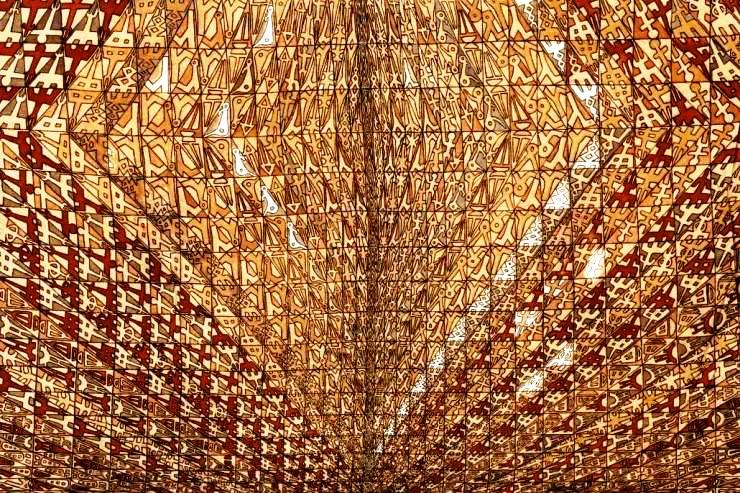
The Groupe Bogolan Kasobané, from Mali, revolutionized the art scene in their country when they abandoned Western painting techniques and, for the first time, applied to contemporary art a traditional Malian technique, Bogolan, which uses clay to paint on fabrics.
The word ‘Bogolan’ in the Bambara language means ‘made from the earth’. It refers to an ancient traditional painting technique from Mali, that uses cotton fabrics hand-dyed with vegetable dyes that react to contact with a type of clay with a high iron content. In addition to the materials, Bogolan is characterized by geometric patterns in shades of yellow and black, with touches of red, brown, and white, with the aim of communicating messages.Initially, Bogolan was practiced by women and was reserved for hunters, warriors, and healers. Several ethnic groups in Mali, such as the Dogon, Bobos, Senufos, Miniankas, Mainkés and Bambaras, practice this traditional art.
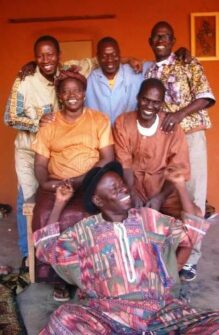
Groupe Bogolan Kasobané , Innovators and pioneers in the Bogolan fine arts movement.
In 1978, the Malian artist Kandioura Coulibaly (1954-2015) brought together five fellow artists – four men and one woman – and created the Groupe Bogolan Kasobané (G.B.K), to do historical research into the Bogolan technique, preserve it, revitalize it, expand it from villages to cities and make it not only an element of national identity but also a reference point and a school of thought for all of Africa. In the group’s name, the term ‘Kasobané’ means ‘no more prison, we are free’, to underline that the group does not use foreign materials, but only national ones, and that Bogolan painting has a place in contemporary Malian art. To achieve their goal, the group members carried out extensive research throughout Mali, living in villages for months and integrating into communities. In the villages, they learned the vocabulary of symbolic images and the meanings of the traditional colours and patterns used.
The G.B.K. has its studio in the capital Bamako and a gallery in Segou, 235 kilometres from the capital. It organizes numerous exhibitions in Mali and around the world and produces costumes and sets for cinema and theatre, as well as fashion fabrics and decorative items.
Tradition and contemporaneousness
The acronym of the G.B.K. group is the signature on each piece, together with the year of creation. This is because instead of making individual paintings, each artist contributed to the creation of the drawing. This is one of its originalities. In addition to being a distinctive element and a real challenge for the ego of each artist, this characteristic of the group is closely linked to its philosophy: the idea of community in African societies, the family mentality, discussing together and, if necessary, to set a work aside to pick up and finish it later. Every time Groupe Bogolan Kasobané decides to create a work, they discuss and decide together on the theme, its composition, and the sketch.
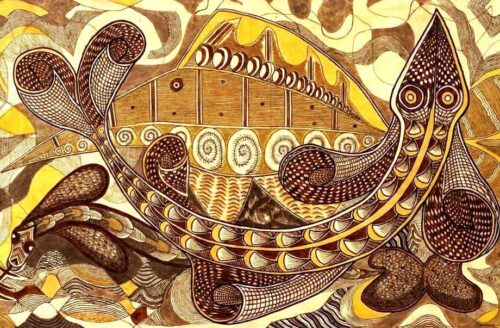
‘Ashanti fish’. Bogolan art has become a vehicle of identity.
Bogolan art has become a vehicle of identity and thought, thanks to the tradition associated with it. The mythology, cosmology and historical aspects of Mali’s ethnic groups are found in the symbolism of its works. One of G.B.K.’s emblematic works is the painting that depicts the Kurukan Fuga Charter, also known as the Mandingo Charter, which was the constitution of Mali and is considered the first human rights charter in history. With its promulgation, King Sundiata Queita sought to abolish slavery in the 13th century and to guarantee personal freedoms, freedom of expression and peace in the Mali Empire, which expanded beyond the current borders of the country that today bears its name. With this painting, the group wanted to demonstrate that Africa also contributed to the development of the world. In the painting we see a semicircle that is gradually breaking down, with a man representing the creator of the graph, Sundiata Queita. Bambara graphic symbols represent power, creation, dynamism, and good people.
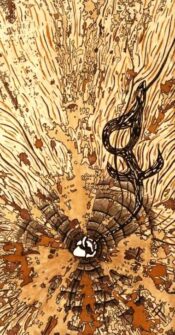
‘The Origin of the Earth’. This painting depicts the creation of the world according to Dogon cosmogony.
Another of the group’s most famous canvases depicts a dark ochre human figure that takes up most of the painting. Inside, twenty-three brown hands with a white symbol on each of them taken from among Bambara ideograms representing elements such as water, air, fire and earth, and others. Above the bust, there are various figures that invite you to analyse the painting in detail: a horse, elephant, a snake, a man in a boat and a woman grinding, as well as many other elements. The work is titled ‘Man Is a Dangerous Animal’ and with it the artists want to remind us that man is a mammal, an animal too, who is destroying nature and therefore destroying himself, because if other living beings disappear, man will also disappear. Exploiting the ancestral dynamic of transmitting knowledge and advice from one generation to the next, Groupe Bogolan Kasobané produces works such as ‘The Origin of the Earth’. This painting depicts the creation of the world according to Dogon cosmogony, according to which a strong wind was unleashed on the universe, it became a tornado, and an egg was formed inside. Thanks to the vibration, the egg hatched, creating land, water, animals, plants, and human beings.
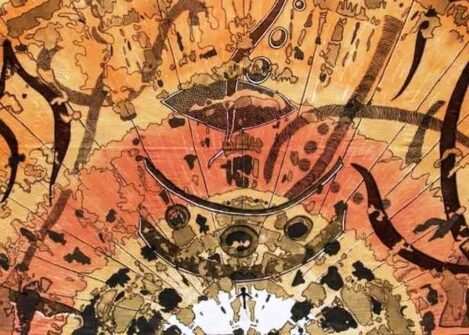
‘The Charter of Kurukan Fuga’, also known as the Mandingo Charter.
And, since it is thanks to women that Bogolan art was born and has spanned the centuries, there are also works that speak of their importance. The group’s founder, Kandioura Coulibaly, said: ‘The woman is the earth and we are on the earth. The woman is also water, and we emerge from the water’.
The importance of the G.B.K. is reflected in the current strength of the Bogolan technique. In Mali, it was disappearing but now it is contemporary art, keeping tradition as the protagonist. Its use in the group’s paintings has thrilled many young artists, who use it as a means of cultural identification and social communication in other ways, including fashion. Photos: Groupe Bogolan Kasobané. Open Photo: ‘Progress II’.
Fernando Féliz



